|
January 3
My close friend Jineen and I try
to take a trip someplace fun and exotic every year; in January
2017 we chose Costa Rica. Leaving out of Dulles on January 3, we
changed planes in Panama City and arrived in San Jose, Costa Rica,
around 5:00 pm. We breezed through customs; being first off the
plane is one of the perks of flying first class, courtesy of
frequent flier miles. I had visited Costa Rica briefly in 2015,
but Jineen had never been there.
We exchanged some money at the
airport without really understanding the currency; the teller gave
us a handful of crisp bills marked 10
mil colones, which he explained were worth about two dollars
each. Apparently one Costa Rican colon
is worth something like 0.0018 of a dollar! We picked up our
rental car, a compact little SUV that drove like it had a few too
many kilometers under its fan belt.
It was rush hour, so our plan was
to visit a grocery store and stock up on ‘happy hour’ supplies
for the week while waiting for traffic to thin down. Navigating by
Googlemaps while we searched for an open shop, we toured several
small streets and questionable neighborhoods, encountering snarled
traffic and drivers with little inclination for yielding the
right-of-way. I concluded that San Jose at rush hour is a
hellhole.
We eventually gave up and braved
rush hour, heading for the town of Cartago where we were staying
that night. Finally locating a small store, we came away with some
white wine in a box (the best they had to offer) and some snacks,
including a fresh mango. We checked in to Grampas Hotel (the
proprietor of which must surely have been Grampa), lugged our
suitcases down the hill (cognizant of the fact that in the morning
we would have to lug them back up), and had happy hour. The box
wine proved to be surprisingly good, but we soon realized our
mistake concerning the mango; we had no knife to cut it up with.
It proved a messy job carving it up with a spoon - but it was
delicious.
January
4
After breakfast we headed out to
visit the Irazu volcano. The narrow road wound up a steep
mountainside, and our little SUV felt like it had seen better
days, the motor laboring as the transmission slipped in and out of
low gear. As the road climbed ever upwards we passed cows and
calves tethered beside it, a colt grazing loose on the shoulder,
and a man mounting up to ride a mule.
Reaching the summit of the Irazu
Volcano, we stood on a high lookout platform. There was a stunning
panoramic view of rugged mountains, dominated by the Turrialba
Volcano to the northeast. We noticed that great clouds of smoke
and ash were rising from it; we had not realized it was so active.
|

The Turrialba
Volcano erupting, viewed from the Irazu Volcano.
|
After a while we went to a lower
viewpoint where we could look down into the double crater below,
surrounded by rock slides and craggy outcroppings. We walked along
the edge of the crater; there were only a few other people there.
We picked up some old pieces of lava; they seemed oddly warm to
the touch and felt alive in our hands. We slipped a few pieces
into our pockets, ignoring the signs that forbid removing any
rocks.
|
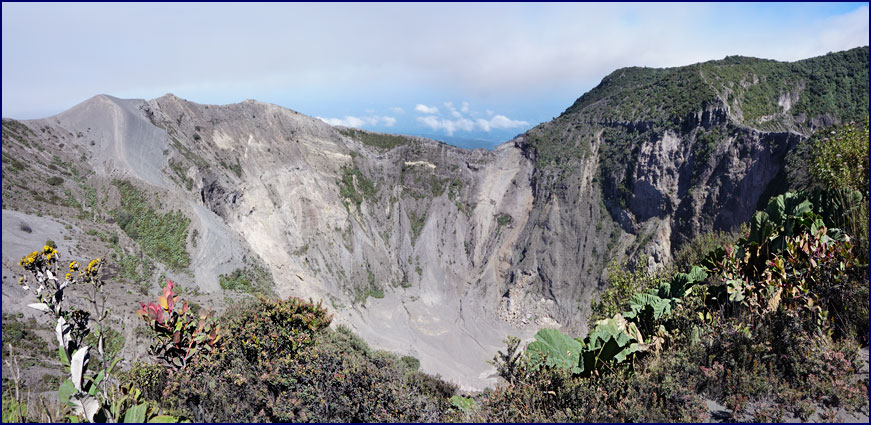
Irazu Volcano
crater.
|
The little car’s brakes squeaked alarmingly as we drove
back down the long steep road. Along the way we noticed some
unfamiliar yellow caution signs that were difficult to interpret;
we were undecided whether they portrayed jellyfish with long
tentacles, a meteor, or flying molten lava fireballs (in
hindsight, probably the latter).
Back in town, we located a decent
grocery store and stocked up on wine and snacks for the week’s
happy hours. Then we set out for the Suria Lodge in the San
Gerardo de Dota Valley, high in the mountains, our home for
the next four nights. The road climbed relentlessly, gradually
leaving the traffic behind. Our tired little SUV struggled up the
steep grades with the motor racing; driving on these steep
mountain roads it was no wonder the transmission sounded bad. I
guess that Costa Rica would be a hard place to be a rental car.
We stopped at a little open-air
restaurant and bought some lunch. We were still quite confused by
the currency; I held out a wad of money and let the proprietor
take whatever we owed him. He chose about eight of the 10
mil colones notes and several coins; I was hoping I hadn’t
just paid $145 for our tacos.
We took the turnoff for the San
Gerardo Valley, and headed into the Los
Quetzales Parque Nacional (Quetzal National Park). We followed
a very narrow winding road which headed steeply downhill. As we
went on the road got smaller and even steeper; it was literally
carved into the sheer mountainside. The pavement soon turned to
gravel, and the gravel to dirt. There were tight hairpin turns
above thousand-foot drop-offs, and places where the side of the
road was severely crumbling away beside deep ravines. No
guardrails, of course. In several places men were repairing the
road by hand, using shovels.
|
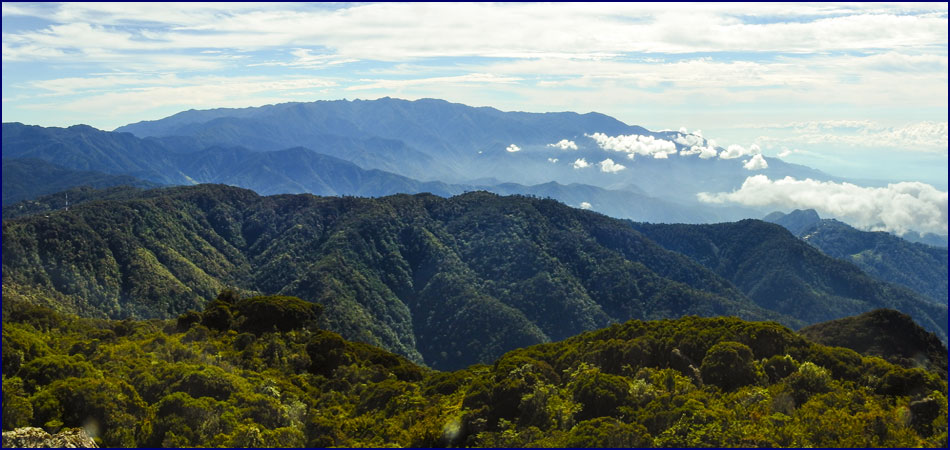
Looking down over the
San Gerardo Valley.
|
The scenery was breathtaking. We stopped the car and gazed
in awe at the tiny ribbon of road winding down through the valley
far below us. Really, it was an impressive feat of engineering
that a road could be built at all on these near-vertical forested
slopes. It was ten kilometers down to the Suria Lodge at the end
of the road, but it seemed more like fifty as we slowly made our
way down the mountainside, brakes squeaking on every turn. I was
glad Jineen was driving!
We passed a
few houses and several lodges; we were amazed that trucks large
enough to haul building materials had been able to drive down the
valley road. There was a tapir crossing sign, but these rare
animals live deep in the forests where they are virtually never
seen.
|

Tapir Crossing! |
We were less than two kilometers from
the Suria when we came to a spot where the road was closed for
repair. We were informed that the repair would take an hour and a
half. We walked down to check out the roadwork; a bulldozer had
dug a huge ditch across the road and the crew was replacing a
large culvert. Three hours later, they finally had it filled in
enough that we could pass. The delivery truck in front of us, with
its wider wheelbase, barely made it across the rough repair,
lurching and swaying precariously as the edge of the road crumbled
out from under it wheels.
|
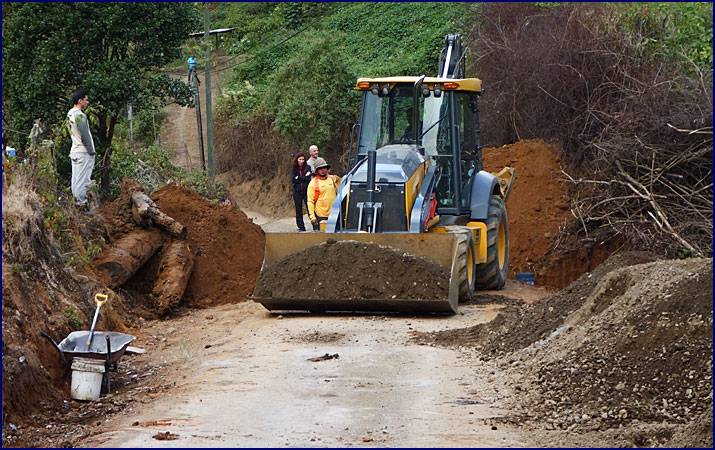
Roadwork
in the San Gerardo Valley. |
It was pitch dark by the time we
eventually found El Hotel de
Montańa Suria, after missing the turnoff the first time. We
checked in with Manuel, who managed the hotel and ran the front
desk. He tried to give us directions to our cabin, but his English
was limited and our Spanish was worse, so it took us a while to
find our room. Later we met up with Agneil, the resident guide,
and made plans for the following day. We were both tired and I was
fighting a sore throat, so we had our happy hour in the room and
then went to sleep.
January
5
The San Gerardo valley is renowned
for its birds. Jineen saw a hummingbird out the window before she
even got out of bed! It was cold at this elevation and the room
had no heater, so we were shivering as we got dressed. We stood on
the balcony and watched the birds in the flower gardens before
going up to the lodge for breakfast. Manuel, the manager, was also
our waiter.
|
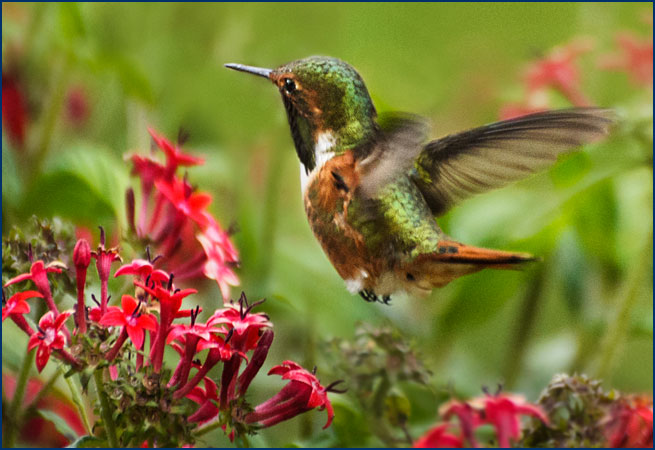
A scintillant hummingbird
greeted us in the morning. |
The Suria was a
lovely lodge; there were a dozen or so cabins with two guest rooms
in each, surrounded by flower gardens. We were in the furthest
cabin, where the lawns and gardens were less formal and more
natural. The restaurant and lounge were in an attractive wood and
glass building, and a cozy fireplace provided some warmth.
|
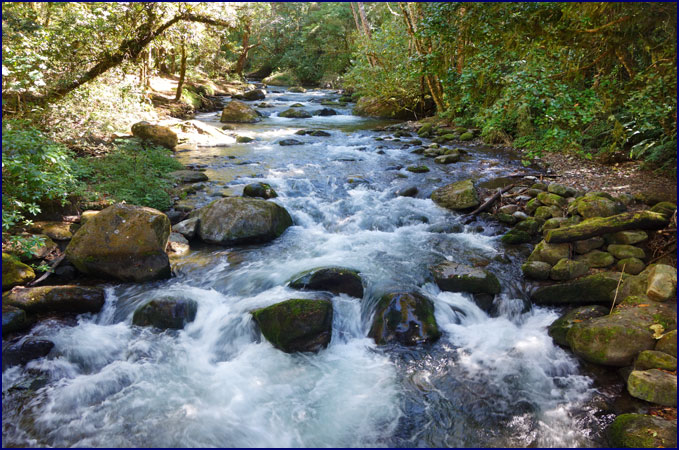
The Savegre River
|
We set out for a hike on the
Waterfall Trail. We walked on the road down a steep hill to the
trailhead. It was a pleasant walk through the woods alongside the
Savegre River, a beautiful rocky stream. A few people were out
fishing. We passed a trout hatchery, and the trail narrowed and
wound through the woods. We knew this area was considered cloud
forest, though in the bright sunshine it didn’t look the part
– very different from the misty cloud forest I had visited in
Monteverdi in 2015.
|
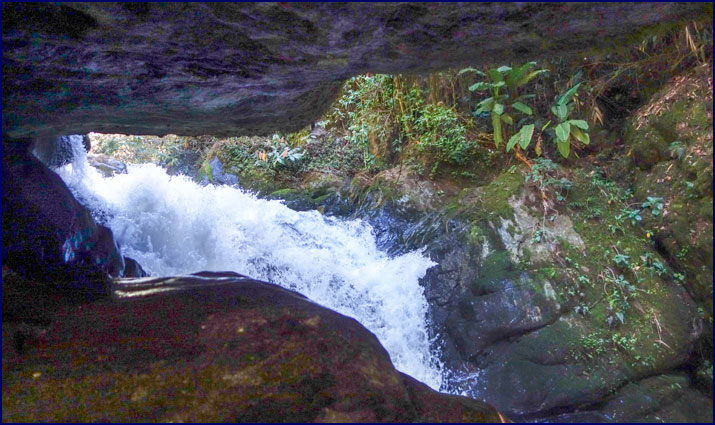
Cave Falls |
After a couple of
kilometers we came to the top of Cave Falls. A boulder the size of
a small house formed a sort of cave, with the water cascading down
past it, very powerful and loud. We climbed down over the slippery
rocks and some steep stairs to see the falls from below. We
propped my camera on a rock to take a selfie beside the water
rushing down through the tiny canyon.
|
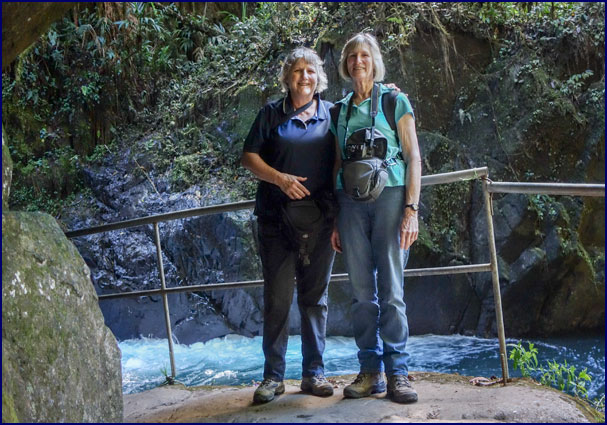
Jineen and I at Cave
Falls. |
The guide, Agneil, had told us that
there was a second, larger waterfall if we continued on, but he
cautioned that the trail was not in good shape. Boy was he right
about that! We
scrambled along the side of a steep slippery slope, clambering
over tree roots and rocks. There were thin ropes stretched
alongside the most treacherous spots to serve as a handrail, and
metal mesh footbridges across narrow chasms. We came across two
ladies sitting in the path; one of them appeared quite weak and
faint - we revived her with chocolate.
|
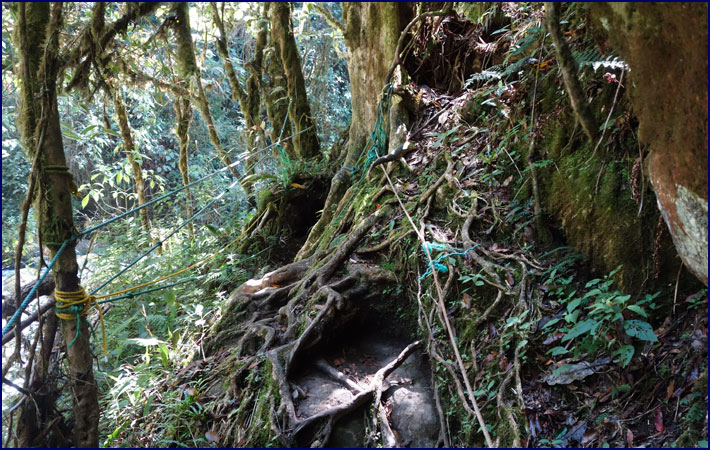
The trail was not in the best of shape! Note the rope
handrails.
|
Before long we came to a rickety
hanging bridge; it looked like something from an Indiana Jones
movie. We crossed it one at a time, carefully, keeping our feet on
the metal support bars, as the mesh flooring was torn through in a
dozen places. On the far side we climbed up a flight of metal
stairs incongruously set in the mountainside, but the mesh treads
were broken out of most of the steps, and entirely gone on the
landing platform.
|

Jineen crosses the Hanging Bridge
|
After about a
kilometer we descended a cliff face by way of a series of more of
the metal stairs built into the mountainside, and these were in
even worse shape. We descended half a dozen treacherous flights,
each in a greater state of disrepair than the last; I clung to the
ropes provided as handrails and carefully picked my way down. I
could hear the roar of the falls below us. We went down the final
hellish staircase and came out to a small cliff above the stream.
Below us was a churning pool, but to the
right our view of the falls was blocked by a big rock outcropping.
There was a sign posted on a tree with the international symbol
for no swimming - a graphic of a person attempting to swim in
turbulent waters, with a red circle with a slash through it.
Looking down, we could see a narrow muddy ledge below us, from
which it appeared there would be a view of the falls. “Let’s
go down there,” Jineen said. What, are you nuts?!
|

No Swimming! |
There was a rope stretched out across
the face of the rocky escarpment. The only way down was to sort of
rappel down backwards, using the rope. Jineen has no fear of
heights, but I do - to me this looked impossible. I was thinking
maybe we could just enjoy the sound of the falls from here, and
look at the churning pool below them . . . but by then Jineen had
already grabbed the rope and slid down to the ledge. Shoot, now I
had to do it!
|

The only way down to Savegre Falls.
|
I grabbed the rope, facing uphill,
and slowly rappelled down the steep rocky face, Jineen encouraging
me as I went. It was
terrifying, amazing. There’s nothing like pushing yourself out
of your comfort zone to feel the full zest of life - but how the
hell was I going to get back up?
We cautiously made our way out on
to the little ledge, and indeed, there was a great view of the
Savegre Falls, thundering down at us from sixty feet above. We
stood there for a while and marveled at the grandeur of it, the
spray from the cascade gently soaking us. We were just starting to
think about making our way back up again when we heard voices, and
a Costa Rican family of about ten people and two dogs appeared at
the top of the outcropping. A man and a young boy rappelled down
with fishing gear and waded unhesitatingly into the swirling
waters, and the rest of them sat down to wait, blocking our route
back to the trail. Getting back up past them appeared challenging.
|
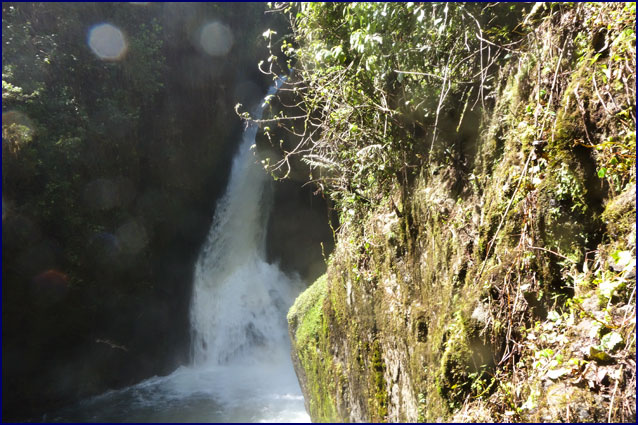
Savegre Falls - I
was too nervous to get a good photo! |
After waiting a while it was evident
that they weren’t going anywhere, so we started climbing up. It
turns out rappelling is much easier done down than up, but by
pulling on the rope I managed to scramble up the hazardous rock
face and clamber past the family. We then climbed back up flight
after flight of those dreadful staircases, our legs burning from
the exertion, and finally made our way back to the trailhead. I
was really wishing that we had parked the car there; the final
steep uphill hike to the lodge was a killer!
|
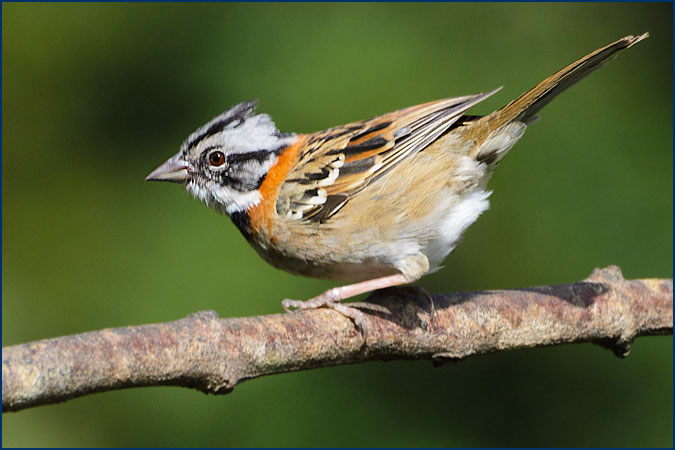
This little sparrow
hung out with us on our balcony. |
We lunched on our happy hour
supplies; cheese and crackers with excellent locally-grown
avocados. We spent a pleasant hour and a half sitting on our cabin
balcony watching and photographing the birds; we could see dozens
of types without even getting up. Little rufous-collared sparrows
hopped around the porch begging for crumbs. Hummingbirds hovered
around the flowers, and a flock of green parakeets flew overhead,
chattering busily.
|

A scintillant hummingbird,
feeding just outside our cabin. |
In the
afternoon we met up with the Agneil for a birding tour. He drove
us in our rental car to Savegre Lodge, where we took a narrow
winding dirt road that climbed quite high up a steep mountainside.
We parked the car and
set out on the one-mile loop birding trail. Agneil carried a large
high-powered spotting scope, and we stopped often to identify
birds. Some of the highlights included the magnificent and
mountain gem hummingbirds, the band-tailed pigeon, the
black-cheeked woodpecker, Wilson’s warbler, and a collared
redstart. If they sat still long enough Agneil could find them
with his scope; amazingly we could take decent photos through the
scope with a cellphone. It was really interesting, and we were
becoming increasingly enthusiastic about identifying the birds.
|

Collared Redstart |
Our trail led through
the cloud forest, though there were none of the misty clouds one
expects. Agneil told us that most of the big trees were oaks; each
was an ecosystem to itself, with many vines, bromeliads and other
plants growing on them. I commented on the difference between this
cloud forest and those at Monteverde; Agneil said it was because
we were at a much higher elevation. We were in the high
montane zone, where Monteverde was low
montane. I still wasn’t sure if that was why the clouds were
missing . . .
|
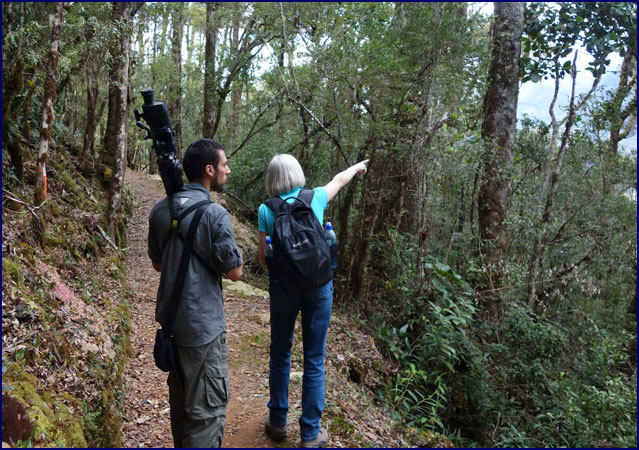
Agneil and Jineen on
the birding trail. |
Agneil was amazing at
spotting birds; he identified dozens of different types - we
wouldn’t have seen half as many without him. Many he found by
first hearing their song. Looking out through the trees, we could
see swifts flying high and buzzards circling over the valley. At
one point Agneil stopped because he heard a faint noise; we
waited, and before long a group of exquisitely marked quail crept
through the underbrush.
|
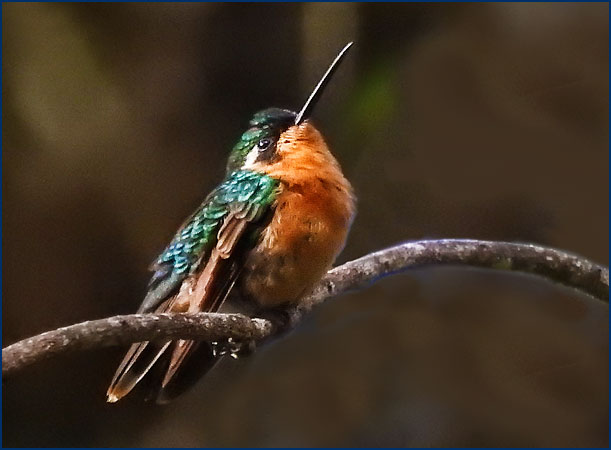
Mountain
Gem Hummingbird |
A bit further on we again heard noise
in the underbrush, but this time it was much louder - something
big was coming! We stood silently, waiting to see what would
appear. A white-nosed coati crossed the trail ahead of us, and
then another. They were so cool! A member of the raccoon family,
the coati has a long nose, a black mask, and a bushy ringed tail.
They look sort of like an elongated raccoon, though a bit larger.
We watched as they snuffled along beside the trail and walked
across a log; they were soon joined by several others, eight in
all. When they moved out of sight we went forward hoping to catch
another glimpse of them; we saw one run up a tree and several
others went crashing off through the underbrush at our approach.
|
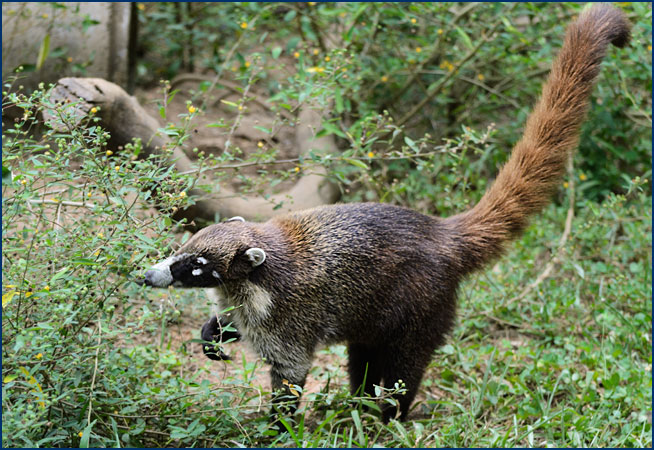
White-nosed Coati. |
We had been out for about two hours
and had covered less than half of the loop trail, so Agneil had us
pick up the pace on the last section, which was all uphill. When
we got back to the car we found a large black bird sitting in a
nearby tree; Agneil identified it as a black guan, a relative of
the turkey.
We had really enjoyed the hike and
learning about the birds. We were tired but happy as we returned
to the lodge and dined on excellent trout, fresh from the hatchery
by the waterfall trail. The temperature was dropping again, so we
asked the manager, Manuel, for a heater for our room; he gave us
one from the unoccupied cabin next door. Much cozier!
|